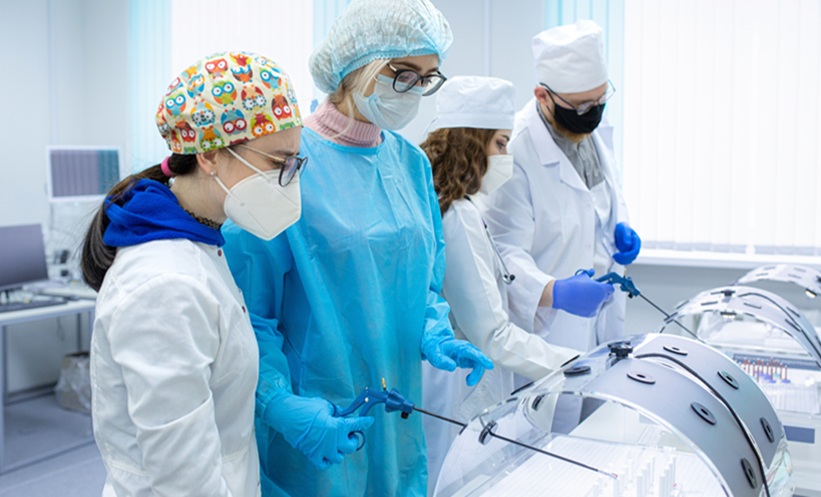L. Sandbergen & J. de la Rosette
Back in the old days, the traditional method of teaching in surgery was characterised by the American surgeon William Stewart Halsted‘s three phrases: “See one, do one, and teach one”. In other words, medical trainees were expected to be capable of performing a certain procedure after observing one being performed. Subsequently after performing it, they should also be able to teach others.
Although Halsted’s model is still in use, the educational and teaching process has evolved with time. New surgical procedures have been introduced, mainly because of the shift from open to endoscopic and minimally invasive surgery. These high-tech procedures require additional training and teaching. During the last decade, live broadcasting of medical and surgical procedures—more commonly referred to as live surgery streaming—has gained worldwide popularity. Whereas this novel way of teaching is embraced by many physicians, others have expressed their concerns with regard to patient safety and privacy, not to forget physician’s liability and safety.
Operating theatres of the 18th century were designed as actual theatres; equipped to accommodate numerous residents, students and other spectators as well. Nowadays, high-quality meetings provide real-time demonstrations of surgical operations. Through live streaming, other practitioners and non-surgeon scientists can experience a surgical procedure in real time and even ask questions to the surgeon without being physically present in the operating room.1
Urology has been at the vanguard of this innovation because of the implementation of endoscopic, laparoscopic and robotic surgical techniques.2 In 2013, the 3rd International Meeting Challenges in Endourology and Functional Urology (CIE) was held in Paris from June 26th to 28th. Co-organised by the AMC (Amsterdam) and Paris VI Pierre and Marie Curie (France) University Hospitals, this premier European meeting in Endourology has been established as a highly educational scientific event. It offers a rich programme focused on innovation, knowledge exchange and valuable networking. Knowledge transfer is delivered through a variety of session types, among which workshops and live surgery sessions stand out for their educational effectiveness.
Over 400 delegates from 48 countries attended the meeting. A total of 38 e-posters were presented in poster sessions with opportunity for discussion and audience participation. In addition, 18 upper and lower-tract endourological procedures for stone disease, urothelial tumours and BPH were performed during the live surgery sessions. The availability of voting pads in specific sessions added additional audience interactivity by allowing attendees to provide feedback and reply to specific questions on cases. Follow-up regarding the outcomes of the live-surgery patients was uneventful.
Critics have claimed that reality is often far away from what one sees on the projection screen of the auditorium during a scientific meeting. This applies for both the patient and the surgeon, as well as for the audience’s perspective. Patients selected for a live surgery are unlikely to be obese, at high surgical risk, to have history of previous surgery, or to be undergoing a potentially difficult procedure. A patient’s safety could be at risk due to supposed increased surgical site infections, reduced quality in outcome, higher complication rates and prolonged anaesthetic time.3-6 Is it safe practice for a ‘famous’ surgeon from another hospital, who has never familiarised him/herself with the patient before the operation, and will not be able to follow the patient after the procedure, to perform the surgery? What about the conditions under which a live operation is performed? The surgeon works in a different operating room, with a new operating team and furthermore, the demands of ‘the performance’, including questions and discussions with the audience, may divert the surgeon’s attention and result in inferior outcomes. Who determines whether the operation the audience is seeing can be considered as teaching/training material or a mere demonstration of pure feasibility, or perhaps worse, an event to attract audiences for the meeting or scientific event?7
Currently the Halsted’s model is highly questioned. Therefore, several leading urological societies have set rules and regulations concerning live surgery in order to set standards of education and patient care. With these policy guidelines, clear conditions under which live surgery should be performed have been formulated. If organisers want their events to be endorsed by the Société Internationale d’Urologie (SIU),8 Endourological Society, European Association of Urology (EAU), and ESUT or EULIS9 (the latest sections of the EAU), they will have to apply and comply with their respective regulatory mandates.
Given the discussion on the possible benefits/downsides of live surgery demonstrations, some experts favour the use of video recordings. Video recordings as teaching tools are claimed to score better than live surgery on every level. They demonstrate surgical procedures and all aspects thereof, and the use of video recordings overcomes the ethical issues described above. Moreover, the video can be stopped at certain points to ask the members of a panel of experts how each of them would handle a specific situation. The audience then learns several acceptable approaches and solutions to that particular problem and is free to proceed with a discussion without any fear of interfering with the surgeon’s performance. So the only thing missing in the substitution of videos for live demonstrations is the lack of drama and the potential for catastrophe that the audience may witness, reminiscent of the bloodlust of the games in ancient Rome.10
There is debate as to whether live surgery is safe and educational, or dangerous ‘edutainment’.2 However, one thing is certain: it is here to stay. For example, SIU Academy—SIU’s official eLearning portal—bridges the gap between those in favour of and those who have doubts concerning live surgery. In the near future, SIU Academy will broadcast live surgeries from centres all over the world, accompanied by expert opinions. This will be the next step forward in teaching and training in urology. And for those who would like to see leading surgeons perform outstanding urological procedures, we hope to see you next year at the 4th International Meeting Challenges in Endourology and Functional Urology!
1. Williams JB et al. Reality Surgery- A Research Ethics Perspective on the Live Broadcast of Surgical Procedures. J Surg Edu. 2011;68:58-61.
2. Challacombe B et al. Live surgical demonstrations in urology: valuable educational tool or putting patients at risk? BJU International. 2010;106(11):1571-4.
3. Pryor F, Messmer PR. The effect of traffic patterns in the OR on surgical site infections. AORN J. 1998;68:649-60.
4. Franke J et al. Complications of carotid stenting during live transmissions. JACC Cardiovasc Interv. 2009;9:887-91.
5. Chatelain P et al. Succes with coronary angioplasty as seen at demonstrations of procedure. Lancet. 1992;340:1202-5.
6. Schmit A et al. Complications of endoscopic retrograde cholangiopancreatography during live endoscopy workshop demonstrations. Endoscopy. 2005;37:695-9.
7. Millat B et al. Live surgery and video presentations: Seeing is believing… but no more: a plea for structured rigor and ethical considerations. Surgical Endoscopy. 2006;20:845-7.
8. CODEX for SIU-endorsed live surgery events. http://www.erasmus.gr/userfiles/file/PDFS/SIU-Live_Surgery_CODEX.pdf. Accessed: August 2013.
9. EAU Policy on Live Surgery. http://www.uroweb.org/events/eau-live-surgery-events/. Accessed: August 2013.
10. Smith A. Urological live surgery – an anathema. BJU International. 2012;110:299-301.
All information obtained by European Medical Journal and each of the contributions from various sources is as current and accurate as possible. However, due to human or mechanical errors, European Medical Journal and the contributors cannot guarantee the accuracy, adequacy, or completeness of any information, and cannot be held responsible for any errors or omissions. European Medical Journal is completely independent of this blog piece, views and opinions expressed are those of the authors.







